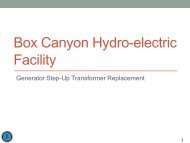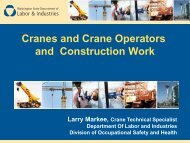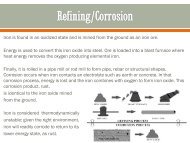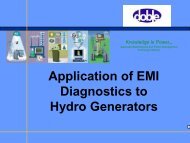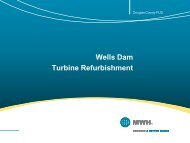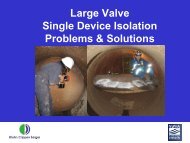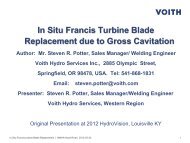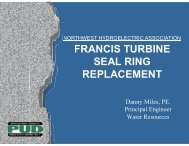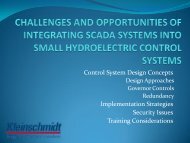ASSESSMENT
penstock condition assessment - Northwest Hydroelectric Association
penstock condition assessment - Northwest Hydroelectric Association
- No tags were found...
You also want an ePaper? Increase the reach of your titles
YUMPU automatically turns print PDFs into web optimized ePapers that Google loves.
Northwest Hydro Association<br />
May 17, 2012 Technical Seminar<br />
PENSTOCK CONDITION<br />
<strong>ASSESSMENT</strong><br />
Thomas L. Kahl, P.E.<br />
Kleinschmidt
TOPICS<br />
• Concerns<br />
• Types of Penstock Failure Modes<br />
▫ Steel and Wood Stave<br />
• Failure Mode Inspection Techniques<br />
• Penstock Safety Program<br />
▫ Recommended Methodology<br />
▫ Example Program
Concerns<br />
• Safe, Reliable, and Economical Pestock<br />
Performance<br />
• FERC’s Primary Concerns<br />
1. The ability to shut down in the event of a leak or<br />
failure is critical. (Penstocks can be physically<br />
large structures with a lot of potential hazards<br />
difficult to detect.)<br />
2. Inadequate inspection.
TOPIC 2 – FAILURE MODES<br />
1.Internal Pressure Rupture<br />
2.General Buckling<br />
3.Local Buckling<br />
4.Inadequate Support
Failure Mode 1 – Internal Pressure<br />
Rupture<br />
Add photo<br />
EPP-8
Failure initiated in heat affected<br />
zone of 1937 vintage<br />
longitudinal weld seam.
Galvanic corrosion at 1953<br />
vintage surge tank longitudinal<br />
weld seam.
Random pitting pattern in 1939 vintage penstock –<br />
(Evaluate per ASME B31G-2009)
Overall Shell Corrosion (typically occurs in<br />
moist environments)
Wood Stave Penstocks<br />
Internal pressure transferred from staves to steel bands.
An example of exterior<br />
stave wood decay.<br />
The ruptured wood at the metal “Kelsey”<br />
butt joint is called “brooming”.
Steel band corrosion
Slippage at shoes can release bands
Seam failure due to gravity dead weight pulling apart<br />
circumferential seam with deteriorated rivet heads.
Failure Mode 2 – General Buckling
2006 collapse of 1995 vintage penstock when ice<br />
plug in vent induced vacuum due to external<br />
pressure.
General buckling caused by uncontrolled release<br />
at rupture. Replacement included additional air<br />
vacuum valves
Blocked vent induced collapse<br />
Note “classic” crack from corner.
Pipe collapsed when decayed top wood stave fell.
Failure Mode 3 – Local Buckling<br />
“Zick” stress deformation at horn of saddle.
Local overhead “dents” in buried pipe probably<br />
caused by concentrated loads.
Relatively rare shear buckling of very thin<br />
(D/t= 614) large diameter steel penstock.
Failure Mode 4–Inadequate Support
Deteriorated saddles
Cracked concrete saddle.
.<br />
Loss of support at tipped saddle
Slope Instability
Surge tanks require<br />
very stable<br />
foundations to<br />
prevent tipping.
Cracked foundation and<br />
buckled anchor bolt gusset.
Surge tank anchor bolt<br />
corrosion reduces<br />
seismic overturning<br />
resistance.
TOPIC 3 – FAILURE MODE<br />
INSPECTION TECHNIQUES<br />
• Shell Thickness<br />
and dimensions.<br />
• Concentrate on<br />
shell Connections<br />
• Supports<br />
New ASCE –MOP 79<br />
expected to be<br />
published Aug 2012<br />
• Corrosion at Steel<br />
to Concrete<br />
Interfaces
Types of Inspection<br />
Cursory Inspection:<br />
Purpose is to note any observable change in condition<br />
Typically performed by operation or maintenance personnel<br />
weekly, monthly, or quarterly.<br />
Changes in condition noted for further investigation<br />
Comprehensive Inspection/Evaluation<br />
Purpose is to review the condition, safety, and risk of the<br />
existing penstock<br />
Performed by engineers who understand the design basis<br />
and actual condition of penstock<br />
If deficiencies are noted they can be resolved by repair,<br />
rehabilitation or replacement.
Basic Tools
Check rivets for loss of<br />
material and tightness.
TOPIC 4 - Penstock Safety Program<br />
Methodology Steps:<br />
1. Establish Baseline Conditions<br />
2. Establish an inspection, monitoring,<br />
and documentation plan<br />
3. Implement a documented<br />
maintenance and repair program<br />
4. Periodic comprehensive<br />
independent condition assessments
Penstock Safety Program<br />
Effective Program Should Be:<br />
• Reliably Able to Detect Problems<br />
• Readily Understood<br />
• Convenient and Usable by Operating &<br />
Maintenance Personnel<br />
• Cost Effective
Ketchikan Alaska Public Utilities (KPU)<br />
Penstock Safety Program<br />
• Ketchikan Lakes Project (4.2 MW)<br />
▫ No. 1 1957: concrete: 1,800’: 54” D: 46’ head<br />
▫ No. 2 1997: ductile iron: 1,800’: 54” D: 46’ head<br />
▫ No. 3, 4, 5: 1957 steel: 350’: 36” D: 250’ head<br />
• Beaver Falls Project (8.3 MW)<br />
▫ No. 1 1966: steel: 342’: 36”D: 321’ head<br />
▫ No. 2 1952: steel: 3,610’: 42”D: 760’ head<br />
▫ No. 3 1953: steel: 4,170’: 28”D: 660’ head
Ketchikan Lakes<br />
Beaver Falls
Step 1 Establish Baseline Condition<br />
• Comprehensive System Description<br />
• Define Design Criteria<br />
• Define Hazards and Risks<br />
• Summarize Physical Condition
Step 2 – Site Specific Inspection,<br />
Monitoring, and Documentation<br />
• Different Portions of a penstock will have<br />
different critical components<br />
• Shell Thickness & Pitting Assessment<br />
• Concentrate in high humid tunnels and in<br />
contact with concrete and soil<br />
• Vacuum valve testing and inspection<br />
• Document supports’ condition<br />
• Critical to have repeatable observation<br />
locations.<br />
• Inspection checklist can be useful to maintain<br />
consistency and completeness.
Step 3: Documented Inspection,<br />
Maintenance, and Repair<br />
KPU already used computerized “Express<br />
Maintenance” program.<br />
Only minor modification needed to existing<br />
procedures to more reliably document all<br />
records for future trending analyses.
Step 4: Periodic Comprehensive<br />
Condition Review<br />
• Either external or internal staff<br />
independent evaluation/audit.<br />
• Frequency 5 to 15 years and after<br />
special events (e.g. earthquake).
Important to<br />
“Expect the Unexpected”
Questions / Comments<br />
Thomas L. Kahl, P.E.<br />
Kleinschmidt Associates<br />
Tom.Kahl@Kleinschmidtusa.com<br />
(207) 487-3328, Ext 280



